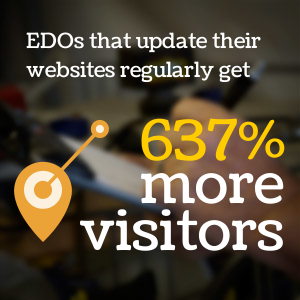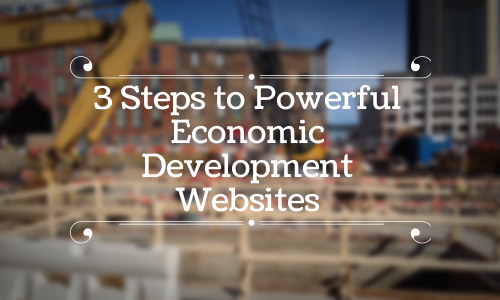When 90 percent of site selection consultants use the internet for site and planning information, it’s clear that your community’s economic development website is its foundation for marketing.
When the time comes to update your website for the digital age, make sure you work with a web design firm that can tell your community’s story with an eye for the competitive realities of your region and a nod to what makes your community unique.
Here are three core principles your web design firm needs to prioritize to build a powerful (and perhaps even award-winning) economic development website.
Summary 3 aspects to an effective economic development website
- Authenticity to your community
- A focus on consultants
- Priority on easy maintenance
1. Authenticity to your community.
Economic development organizations understand that their community is unique. So if your community isn’t like anyone else’s, why make your website like everyone else’s?
Your in-depth knowledge of your community needs to be clear on your website, and your website design firm should be prepared to show visitors exactly what makes your community the best place to live, work, and do business. Only then will it reflect the true character, personality, and strength of your region and do what you want it to do: attract business to your community. Here are a few strategies for starting this conversation:
- Interview your staff. Figure out what resonates with your audience by interviewing executives that moved their companies to your community. Why did they choose your community? What do they love most about it? These seemingly-informal questions can help bring a touch of life to your website design.
- Use local resources. When you’re gathering information for your website, make sure you take into account already-existing local resources. What community assets (including local events, business associations, and attractions) can you feature?
- Leverage your BRE. Your business retention and expansion efforts can play a huge role in determining what advantages to highlight on your website because they meet with companies in your area on a regular basis.
- Ask questions about your audience. Audience research is a must, and not just for site locators. What does your primary audience want to hear about? Expand this circle to include local companies, location advisors, and entrepreneurs. Answer the simple questions they have and they’ll come to you for the tough ones.
- Make sure your property listings are up to date. Your community is only as competitive as it is ready for business. So make sure your property listings are up to date. Include listing price, square footage, and selling agent. Then go a step further and work with brokers to make sure your properties are as advertised and ready for use.
2. A focus on location consultants.
Your website is your first impression, one of the first indicators to a location consultant that your community is easy to access and up to date. So what kind of message does a confusing, out of date website send? Make it easier for site selectors and location consultants to recommend your community with the following updates:
- Make it mobile. Half of web traffic comes from mobile devices, and that includes location consultants who are likely to be on the road most of the time. Optimize your website for mobile and tablet traffic to make reviewing your website a pleasure, not a pain.
- Make it easy to find information. Clearly organized data such as maps, site and property listings, and reports will show prospects and consultants that you know how to organize information and speak to their need.
- Make it easy to share information. Whether or not your target audience is active on social media platforms, it’s still important to make your content easy to share with “share this” widgets. Extra credit? A custom report builder that allows them to select the data that they need and bundle it into a branded PDF package. Both of these strategies will make it easy for prospects to find information and share it with others.
3. Prioritize easy maintenance.
The biggest indicator of long-term website ROI is your team’s ability and inclination to update it. And if you’re none too tech-savvy, that can translate into a website that goes cold after a few months for lack of technical knowledge. Here are topics to approach with your web design firm to make sure you keep a long-term ROI on your website:
- Look for non-technical software or applications. Turn to a website solution that’s easy to maintain without a heavy ongoing expense. You can achieve this by using a content management system (CMS) that allows a nontechnical staff to maintain it.
- Look for ways to include simple, quick updates. To make it clear your website is being updated frequently, look for ways to include simple, quick updates like a news feed or social media widget. The right CMS will also allow you to make news and press release updates easily, allowing the site to function as marketing tool and internal information tool at the same time.
- Keep an eye on the future of your organization. Consider what changes you’ll need to make in the future (say, if three of your properties are snatched up today) and make sure you know how and where to update. Also, keep an eye on information and resources that may need to be updated or removed in the future. Many sites have multiple formats of content (think PDF, videos, links, and text) and might find themselves with a jungle of updates when the time comes -- or worse, an outdated website with varying levels of correct information.
 We did a study of all the economic development websites we've created -- 24 to date. Those EDOs that updated their websites on a regular basis receive 637% more website traffic than those EDOs whose websites are dormant.
We did a study of all the economic development websites we've created -- 24 to date. Those EDOs that updated their websites on a regular basis receive 637% more website traffic than those EDOs whose websites are dormant.
Have a maintenance or publishing plan. How will you add new information that your prospects are interested in? Devoting time to planning will help keep you ahead of the game.
We believe that your website is an extension of your community’s personality. And that’s what your online presence needs to show off: an organized, attractive story about your community’s unique strengths. It’s only when your website tells your unique story that you’ll see the results you want: increased traffic, prospect engagement, and economic growth.









